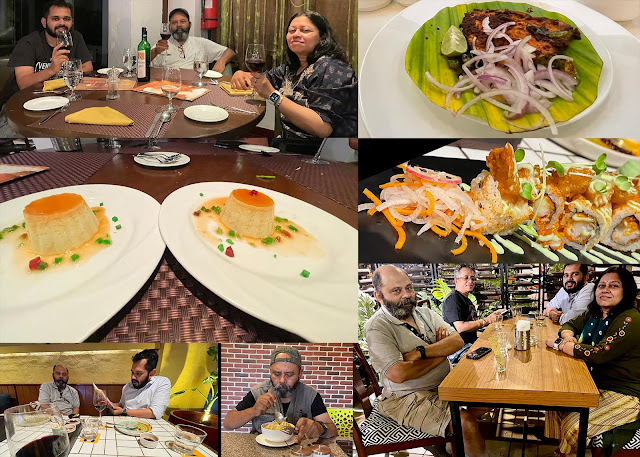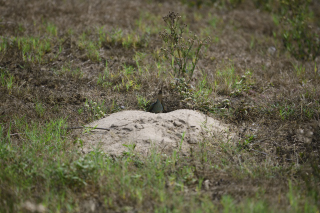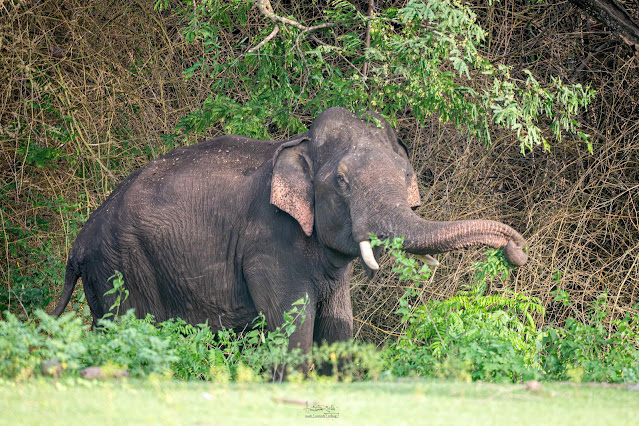RADventure 2023: Episode 5 : Western Ghats ... where my thought's escaping! From Ujjain to Masinagudi (March 22 - May 28, 2023 )
Western Ghats ... where my thought's escaping
all playing the same old game!
arch 22, 2023, 0530 hrs, moments before daybreak,
we set out from Ujjain, the abode of Mahakal, towards my brother-in-law's home
in Thane, Maharashtra. A distance of 630 Km, to be covered in 12 hours per
Google's prediction. In no time, we
were cruising past Indore well before its residents stepped out of
their slumberland. From our earlier experience on this route, the drive, as expected, was fairly comfortable, especially with a double-lane carriageway end-to-end.
|
With a few breaks on the route, at 1555 hrs, we arrived at Prasenjit Guha my Brother-in-Law (B-I-L)'s pad well ahead of Google's estimated arrival time. Pleasantries done. While the evening unfolded, the ambience turned into a cheerful mood for my B-I-L, a whiskey aficionado and collector extraordinaire, shared some of his finest collections as we caught up with tales & travails of the past. What more could our weary bodies and battered souls have possibly yearned for after being on the road for a month! It was like a divine gift served with a twist of merry mischief!
Fuelled by scrumptious food and a blissful night of solid zzZs, we hit the road the following evening, headed towards Versova—our son Anubhav's humble abode. Over the years, Anubhav has become quite the foodie maven while honing his legal dexterity. For the next two weeks, our agenda was clear: catching up with friends and family in the city and embarking on mouthwatering culinary escapades, all under the guidance of Anubhav. It was a feast for our taste buds and a heartwarming reunion, all rolled into one!
 |
| Mumbai & Goa were all about gastronomic celebrations! |
We (Runa, Anubhav & I) hit the road to Goa on April 04 - a pleasant 11 hour drive. At Goa, Anubhav & I decided to try out the Open Water Basic Scuba certification with Dive Goa (divegoa.com). Marine exploration has been a long pending agenda on our bucket list. We chose to stay at Victoria Villa (www.victoriavillaguesthousegoa.com) in Sinquerim- Candolim, a wonderful and cosy guesthouse managed by exceedingly hospitable hosts - Salvador & Irene, a 10-minute walk from our dive school.
 |
Anubhav during his 'Open Water' dive |
Oh, the hypnotic appeal of Goan food drives you crazy! Thus the evenings in Goa was the continuation of our gastronomic experiments that started at Mumbai, while we spent the day Scuba-dive training.
Mission accomplished, on April 10, 2023, the wheels of our Brezza got rolling once again as we departed from Victoria Villa. On the way dropped Anubhav at the new Manohar International Airport at Mopa (North Goa) and headed south towards our base at Pandavapura. En route, we stopped for the night at a small village-town ... Chitradurga, an ancient fort city.
Crossing into Karnataka from Goa, we encountered frequent police check-posts (every 50-70 km) due to the upcoming state assembly elections that were to be held in May 2023. At every check-post we had to undergo vehicle inspection, fill in contact details, and in some cases even video-graphed, all of this to ensure no illicit items or cash was being smuggled into the state to influence elections. At one check-post, an inquisitive bunch of cops were quite intrigued by our drive from West Bengal to Karnataka refusing to believe that our trip had nothing to do with the election! Despite those random restrains, the drive to Sharadindu, Pandavapura, was pleasant and hassle-free. We arrived at our home, away from home, on April 11, 2023, just in time for a revitalising lunch.
During this trip spotting the Yellow-throated Bulbul became the most significant achievement. This elusive bird dwells on steep rock faces, and despite multiple attempts in the past, I had failed to catch a glimpse of it. My best chance was the rugged cliffs of Melkote, adjacent to the wildlife sanctuary, where some sightings had been reported before. Determined, I visited the location once every week, climbing higher each time, until I heard a unique and melodious song, unlike any common bird in the area. The captivating melody emanated from a banyan tree near the cliff's summit. Finally, I laid eyes on a bird with a yellow hue resembling a bulbul. Initially, I assumed it was a White-browed Bulbul, which is common in that region, but as I observed it closer, its unmistakable yellow throat was distinctly visible. A pair of Yellow-throated Bulbul were busy building their nest close by.
 |
| The Yellow-throated Bulbul at Melkote |
The other exciting birding feat was near Pandavapura on the banks of river Kaveri, at the Blue-tailed Bee-Eater Reserve. Having learnt about this protected place from friends at Sharadindu, Runa and I visited the location one morning. Being the breeding season for the birds, the forest department had cordoned off the place where the nests existed along the sandbanks. For the first time, I experienced a proactive Forest Department, who have earmarked the 2.5 acres in Naguvanahalli on the banks of the river Cauvery as a reserve dedicated to this bird.
 |
| The Blue-tailed Bee-eater (Merops philippinus) at the Bee-Eater Reserve, Nagavanahalli |
Though a common bird across the Indian sub-continent, this was the first time I could observe hundreds of them for a significant time. These chirpy birds were busy catching dragonflies and insects and carrying them into their burrows in the sand. I watched their wonderful world for over an hour before returning to Sharadindu.
 |
| The Blue-tailed Bee-Eater eats honeybees, wasps, hornets, beetles, bugs, flies, moths, butterflies and dragonflies |
 |
| The Blue-tailed Bee-Eater builds its nest in burrows on sand banks |
The other positive development was to find an enthusiastic birding partner in Dr. Shiva Kumar who also happens to be our neighbour at Sharadindu. Dr Shiva Kumar is a remarkable individual who embodies a diverse range of passions and talents. Not only an accomplished pharmacy expert Shiva (as he is fondly called) is a certified scuba diver, a long-distance runner, combined with his unwavering love for nature, creates a unique perspective that enriches our birding experiences. It was Shiva's presence and his good fortune perhaps, that helped in the sighting of the Yellow-throated Bulbul.
 |
| With Dr Shivakumar - our neighbour and birding partner at Sharadindu. |
As soon as the state elections were over,all the checkposts disappeared, we made two short trips worth mentioning. The first one was to Waynad in Kerala, followed by a trip to Masaniagudi (Tamil Nadu) in mid-June. The drive was exhilarating and inspiring, wheeling through the Nilgiri Biosphere that encompasses Bandipur & Mudumalai National Parks. At Wayanad we were joined by Abhishek (our nephew), Sonia and their 13-year-old son Kanishk (Tin-Tin). Abhishek had been requesting that we make a trip together for quite some time, which Runa and I were equally keen too. Knowing full well the trio's undeniable passion for nature and wildlife,
I found myself wondering just how far they'd be willing to venture into
the untamed wilderness. I've had a rather comical encounter in
the past that left me with a jolt of realization. It involved another
friend whose idea of wildlife exploration was to perch himself
comfortably in the balcony and observe whatever feasible from the safety and comfort of his lodge. He would'nt budge from the place fearing insects, animals and above all a risk to his life. So, with a mix of excitement and caution, I braced myself and booked the stay at Greenish Fence, a nature heritage home in Wayanad, a farmhouse in a hilly locale with Coffee, Areca and Palm trees. It was an independent bungalow amidst plantations all around. Location-wise, no regret; however, the school holiday season, the heat of the summer, and the absence of wildlife in the vicinity left me unsatisfied with the overall outcome. Now that I better appreciate their appetite, next trip for sure, Abhishek, I promise some memorable adventures!
From Wayanad, Runa and I drove to Masinagudi while Abhishek and his family returned to Bangalore. At the time we visited, i.e. latter half of June, huge crowds had been thronging Masinagudi consequent to the Oscar-winning documentary 'The Elephant Whisperers', shot at the Elephant Rescue and Rehabilitation Center at Mudumalai National Park. We were lucky to have booked ourselves well in advance at Wildways Madumalai Homestay, as the holidayers took most of the available accommodation in this small village town.
Masinagudi located in the buffer zone of Madumalai Tiger Reserve, Tamil Nadu, has recorded almost 260 bird species. Our quest to spot these avian treasures was guided by none other than
Abid, a remarkable individual who wears the hats of both a knowledgeable
naturalist and a welcoming homestay owner. Abid's unwavering dedication
to the Nilgiris Biosphere, where he has spent his entire adulthood for the cause of
conservation and exploration, is highly commendable.
The sweltering heat and the belated arrival of the monsoon were acting as dampeners to our birding endeavors. Nevertheless,
undeterred by the adverse conditions, we pressed on, determined to make
the most of our time in Masinagudi and uncover the beauty of its
feathered inhabitants.
 |
| A family of Smooth-coated Otter (Lutrogale perspicillata) on the banks of Achakarai Road canal. Listd as Vulnerable in IUCN Redlist with its population decreasing due to habitat loss |
Apart from the avian sightings, two remarkable mammal encounters wrapped up the trip. We bumped into a male tusker (elephant) while exploring on foot. All of a sudden the tusker emerged from a dense bamboo thicket hardly 30 feet from us. Just moments before the tusker's appearance, we had been leisurely exploring the same area in search of birds. And then suddenly, from the shadows, emerged this magnificent beast. In my eagerness to capture head-on photographs, I was inclined to stand my ground. However, Abid, displaying his profound understanding of wildlife and prioritizing our safety, swiftly pulled me away, urging us to retreat to a safer distance.
Moments later, I realised my mistaken priority; it could have been fatal should the tusker have chosen to charge from that close distance. While I may have missed the chance for those up-close photographs, the
encounter served as a poignant reminder of the power and
unpredictability of the natural world. It was a humbling experience that
left me in awe of the grandeur of these creatures and deeply grateful
for Abid's guidance and expertise in ensuring our well-being.
Stepping away we watched the pachyderm continue its foraging routine, and soon dissapeared into denser growth.
 |
| On the way to Singara, where we had a close encounter with a leopard |
The other incident occurred near the Singara Check Post (Hydroelectric Project). On our return leg from the checkpost, soon as we turned around, piercing through the air, we heard the frantic alarm calls of
Giant Malabar Squirrels and Bonnet Macaque monkeys echoing from the
treetops surrounding the coffee plantation. Our instincts kicked in
simultaneously, and Abid, Runa, and I realized that this symphony of
warning shrieks could only mean one thing—a formidable predator was
lurking nearby. We stopped our car and stepped out. Abid walked, scanning the front, while I moved towards the car's rear, trying to peer down the slope towards which the monkeys were staring and yelling.
And then, as if emerging from the depths of a thrilling dream, it happened—a leopard sprang out from under the bushes, quite perturbed by the cacophony of the squirrels and monkeys. In that surreal moment, mere feet away from me, our eyes locked in mutual surprise. We both froze in our tracks - momentarily frozen in time.
But as quickly as the leopard appeared, it vaulted across the road, disappearing into the opposite section of the coffee plantation, vanishing into the wilderness beyond. Still holding my camera, I remained motionless, a statue of awe and regret. Only later did the weight of the missed opportunity sink in, as I realized the extraordinary spectacle I had been on the verge of capturing. Yet, despite the temporary disappointment, the swift exit of the leopard was a fortunate turn of events. Averting what could have been a perilous encounter with a hungry leopard, given the unexpectedly close proximity.
The encounter left us breathless, a thrilling testament to the raw power
and untamed beauty of the natural world. It served as a vivid reminder
of the wild wonders that lie just beyond our reach, always ready to
surprise and captivate us in ways we could never imagine.
 |
| Episode 5 : The Route Traversed |
7114 Km covered, 99 days on the road, a few lifers sighted, a couple of close & wild encounters, it was time to head homeward. To add some spice to our adventure, instead of heading east, we drove southward venturing into the vibrant and aromatic realm of the Spicy State and God's Own Country, tracing Kerala's enchanting coastline.
In our upcoming and final episode, we will delve into the captivating
tales of our Malabar escapade, exploring the wonders that unfolded along
Kerala's soul soothing coastal strip. From pristine beaches to lush
backwaters and immersive cultural
experiences, our time in this magical region was nothing short of
enchanting. And as our wheels turned towards the end of our journey, we
will also share the exciting details of our home run, rounding off our
expedition with a sense of fulfillment and anticipation for the tales
yet to be told.
Do continue to share your feedback & comments which we eagerly await to hear.
Cheers!










Comments
Fascinating stories!
To more such trips...
Every minute I spent in all our 3 recent jaunts with you are the best cherished. Thanks for introducing me to “Birding” & offering me 2 books to keep up with my interest. I wish we could walk into wilderness to sense the subtleties of wild more often. In next visit to Shardindu, shall we venture to meet Leopards at night on cliffs of Pandavapura? Thanks in abundance for your nice words about me; will strive to live up to them in further more
Wishes for more birding accomplishments..